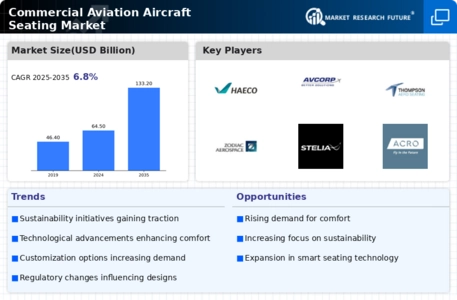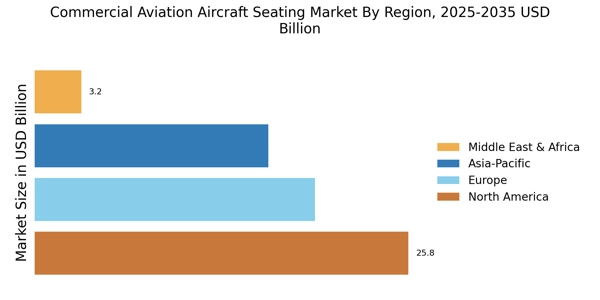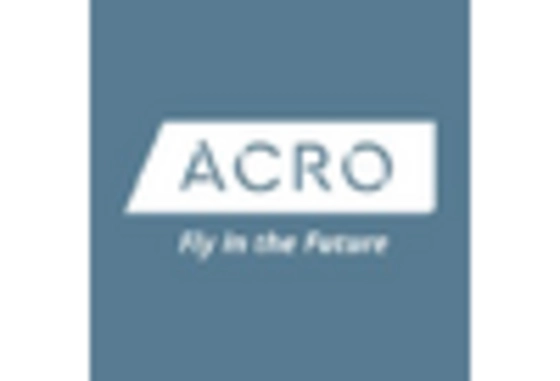Rising Air Travel Demand
The Commercial Aviation Aircraft Seating Market is experiencing a notable surge in demand due to the increasing number of air travelers. As more individuals opt for air travel, airlines are compelled to expand their fleets and enhance passenger comfort. According to recent data, the number of air passengers is projected to reach 8.2 billion by 2037, indicating a robust growth trajectory. This rising demand necessitates the development of innovative seating solutions that cater to diverse passenger needs, thereby driving the market forward. Airlines are investing in modern seating designs that not only improve passenger experience but also optimize space utilization. Consequently, this trend is likely to bolster the Commercial Aviation Aircraft Seating Market as airlines strive to remain competitive in a rapidly evolving landscape.
Focus on Passenger Comfort
In the Commercial Aviation Aircraft Seating Market, there is an increasing emphasis on passenger comfort, which is becoming a critical differentiator for airlines. As competition intensifies, airlines are recognizing that enhanced seating can significantly influence customer satisfaction and loyalty. Recent studies indicate that 70% of travelers prioritize comfort when selecting an airline, prompting carriers to invest in advanced seating technologies. Features such as adjustable headrests, increased legroom, and ergonomic designs are being integrated into new aircraft models. This focus on comfort not only enhances the travel experience but also encourages repeat business, thereby driving growth in the Commercial Aviation Aircraft Seating Market. Airlines that prioritize passenger comfort are likely to see improved brand loyalty and market share.
Technological Advancements in Seating
The Commercial Aviation Aircraft Seating Market is witnessing a wave of technological advancements that are reshaping the seating landscape. Innovations such as lightweight materials, smart seating solutions, and integrated entertainment systems are becoming increasingly prevalent. For instance, the introduction of composite materials has led to a reduction in seat weight, which in turn contributes to fuel efficiency and lower operational costs for airlines. Furthermore, the integration of technology into seating, such as USB charging ports and adjustable features, enhances the overall passenger experience. As airlines seek to modernize their fleets, the demand for technologically advanced seating solutions is expected to rise, thereby propelling the Commercial Aviation Aircraft Seating Market forward. This trend suggests a future where seating is not only functional but also a key component of the in-flight experience.
Sustainability and Eco-Friendly Practices
Sustainability is becoming a pivotal driver in the Commercial Aviation Aircraft Seating Market as airlines and manufacturers increasingly adopt eco-friendly practices. The aviation sector is under pressure to reduce its carbon footprint, prompting a shift towards sustainable materials and production processes. For instance, the use of recycled materials in seat manufacturing is gaining traction, aligning with broader environmental goals. Additionally, airlines are exploring options to reduce weight in seating, which can lead to lower fuel consumption and emissions. This focus on sustainability not only addresses environmental concerns but also appeals to environmentally conscious consumers. As the demand for sustainable solutions grows, the Commercial Aviation Aircraft Seating Market is likely to evolve, with manufacturers innovating to meet these expectations and enhance their market position.
Regulatory Compliance and Safety Standards
The Commercial Aviation Aircraft Seating Market is significantly influenced by stringent regulatory compliance and safety standards. Regulatory bodies are continuously updating safety protocols to ensure passenger protection during flights. This has led to an increased focus on the design and manufacturing of aircraft seats that meet these evolving standards. For example, the Federal Aviation Administration (FAA) mandates specific crashworthiness requirements for aircraft seating, compelling manufacturers to innovate and enhance seat designs. Compliance with these regulations not only ensures passenger safety but also impacts the overall market dynamics. As airlines and manufacturers strive to meet these standards, the demand for compliant seating solutions is likely to grow, thereby driving the Commercial Aviation Aircraft Seating Market. This regulatory landscape presents both challenges and opportunities for stakeholders in the market.


















Leave a Comment